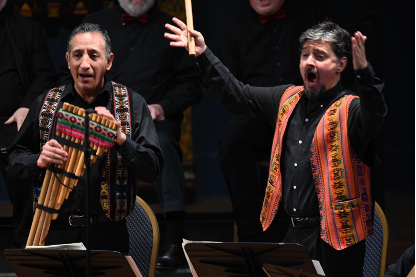“Cantos y Suspiros – Songs and Sighs” – Early Songs and Dances of Spain and Latin America
Recorded February 4, 2023 @ 4 pm
Trinity Church,
Lakeville, CT
Performers:
Camila Parias, soprano
Job Salazar, violin
Gina Allende, viola da gamba
Christa Patton, harp
Christine Gevert, virginal, organ
Ben Harms, percussion
Program
Anon., Spain 17. cent
Versillos I & VI del Cuarto Tono
Virginal
Sebastian Durón (1660-1716)
“La Borrachita de Amor” with harp tabulature
Soprano and basso continuo Barcelona, Biblioteca de Catalunya, M. 3660
Diego Fernadez de Huete (1657-1722)
Passacalle de Proporzion al Octabo Tono
Instruments
Compendio Numeroso (1702); arr. Christa Patton
José Marín (1619-1699)
“Corazón que en prisión” with harp tabulature
Soprano and basso continuo Madrid, Bibiolteca Nacional Ms. M-2478
Santiago de Murcia (1673-1739)
Folias Gallegas
Guitar
Saldívar Codex (1732)
Juan del Vado (1615-1691)
“No te embarques, pensamiento”
Soprano and basso continuo
Anonymous
Tiento
Harp Libro de cifra Nueva … deLuys Venegas de Henestrosa (1557)
Juan Hidalgo (1614-1685)
“Rompa el aire en suspiros” Recitativo a lo humano
Soprano and basso continuo
Anon., Spain 17. cent.
Versillos II, V & VIII del Cuarto Tono
Virginal Biblioteca del Orfeo Catalá
Domenico Zipoli (1688-1726)
Retirada del Emperador de los dominios de S.S.
Virginal andviola da gamba
Archivos de San Ignacio y Concepción (Moxos y Chiquitos), Bolivia; arr. Christine Gevert
Anon. Spanish 17th c.
“¡Al sarao, que el Amor,…!” / Canzona Francesa
Soprano and basso continuo
Biblioteca Nacional Ms. 3950
INTERMISSION
Cristóbal Galán (1625-1684)
“Pajarillo que bien cantas ausente”
Soprano and basso continuo
Juan Hidalgo (1614-1685)
“Tenebrosa noche”
Harp
José de Orejón y Aparicio (1705-1765)
Aria “Mariposa de sus Rayos”
Soprano, violin, organ, and basso continuo
From Cantada a sola al Santísimo Sacramento, Archivo Arzobispal de Lima
Domenico Zipoli (1688-1726)
Movement 1 from Violin Sonata in A major
Violin and basso continuo
Juan Corchado (1725-1728)
“Nace la aurora divina”
Soprano and basso continuo Archivo Catedral de Santiago, Chile
Domenico Zipoli( 1688-1726)
Movements 3 & 4 from Violin Sonata in A major
Violn and basso continuo
Anon., Chile
“Embeleso de mi alma”
Soprano, violin, organ, basso continuo Archivo Catedral de Santiago, Chile;
arr. Christine Gevert
Santiago de Murcia (1673-1739)
Otros Canarios
Guitar
Saldívar Codex (1732)
Diego Fernadez de Huete (1657-1722)
Canarios
Guitar and harp
Compendio Numeroso (1702)
Anon./ Lucas Ruiz de Ribayaz(1626-c.1677)
“Canario bona de rufa y fa”/Canarios
Soprano and instruments
Archivo Musical Archivo de la Catedral de Bogota: Villancico al Nacimiento Negro (1704) /Luz y Norte, Madrid 1677
Gaspar Sans (1640-1710)
Canarios
InstrumentsInstrucción de música sobre la guitarra española, Zaragoza, 1674s; arr. Christa Patton
Transcriptions/Editions: Grant Herreid, Christa Patton, Lola Josa & Mariano Lambea,
Paul G. Feller-Simmons, (Lilly Library, Indiana University, Bloomington, Indiana)
Learn More About All of the Performers
Christa Patton, historical harpist and early wind specialist, has performed throughout the Americas, Europe, and Japan with many of today’s premier early music ensembles including Piffaro the Renaissance Band, Early Music New York, Boston Camerata, The King’s Noyse, Folger Consort, Newberry Consort, Apollo’s Fire, Parthenia, ARTEK and Chatham Baroque to name a few. As a Baroque harpist specializing in 17th century opera, Christa has performed with New York City Opera, Wolf Trap Opera, Opera Atelier and the Opera Theater of Saint Louis.
As an educator and scholar, Christa has served on the faculty of Rutgers University and the Graduate Center at CUNY. She is also the director of the Baroque Opera Workshop at Queens College, a workshop specializing in period-specific performance practice of 17th century musical drama.
In the recording industry, Christa has fulfilled both the role of recording artist and record producer. As recording artist whe can be heard on Zefiro Recordings – Monteverdi Il quinto libro dei madrigali, ARTEK, and Monteverdi: The Complete Madrigals, Book 7, ARTEK; ATMA classiques – Palazzo Romano, La Nef; Ex Cathedra Records – Venice and A Bohemian Christmas, Early Music New York; Dorian Records – Chacona, Ex Umbris; Stadtpfeiffer and Trionfo d’Amore e della Morte, Piffaro; Navona Records Los Ministriles in the New World, Waytes, Vespers, Back before Bach, Piffaro; Lyrachord Label Istanpitta I, Early Music New York, Istanpetta II, Early Music New York. As record producer: ATMA – 17th century Italian motets, ¡Sacabuche!; Acis –In Sara Levy’s Salon, The Raritan Players

Christine Gevert, virginal, holds a master’s degree in organ and early music performance from the Hochschule für Musik und Theater, Hamburg, Germany. After earning a bachelor’s degree in music theory from the Conservatorio Nacional de Chile, she studied choral and orchestral conducting in Berlin and harpsichord in London. She has taught at the Berliner Kirchen-musikschule, the Universidad de Chile, and the Pontificia Universidad Católica in Santiago, Chile.
While conducting and performing in Europe and South America, she also recorded for Carpe Diem and Alerce. She has led master classes and workshops in early music, harpsichord, and baroque vocal technique at music festivals in Germany, Chile and the U.S., and has taught historic keyboards at the Berlin Church Music School in Germany, and locally at Bard College at Simon’s Rock. Ms. Gevert has appeared at the Washington Early Music Festival, the Berkshire Choral Festival, the Fringe concerts of the Boston Early Music Festival, and the Amherst Early Music Festival.
In recent years she has given solo harpsichord recitals at the Early Music Festival in Narol, Poland, at the historic Auditorium Wanda Landowska near Paris, at the Metropolitan Museum of Art, and the Brooklyn Beat Festival. She performed at the International Festival of American Renaissance & Baroque Music at the Chiquitan Missions in Santa Cruz, Bolivia. She has authored and published more than eighty historical basso continuo realizations with the Swiss music publisher, Amadeus Verlag. The founder and artistic director of Crescendo and her own baroque ensemble Les Inégales, Christine is currently music director at Trinity Episcopal Church, Lime Rock, CT.
Crescendo and its programming
Crescendo is a national-award-winning music performance organization. For more than fourteen years, Crescendo has presented concerts year-round in northwestern Connecticut, the Berkshires, and the mid-Hudson Valley of New York. The organization is based at Trinity Church Lime Rock in Lakeville, CT.
Founder and Artistic Director, Christine Gevert, is celebrated for her innovative approach to programming and performance. Crescendo’s audiences are often rewarded with programs of rarely-heard and newly discovered works. Often Ms. Gevert uses original manuscripts to make her own performing editions for chorus, soloists and orchestra because there are no existing published editions. Frequently our programs feature early and contemporary music works alongside each other, creating a contrast for the listener. Eight new works have been commissioned for our chorus and vocal ensemble. Crescendo has presented ten U.S. premieres.
Crescendo’s innovative programming relies on a local base of dedicated and talented auditioned amateurs and professionals who make up the Crescendo Chorus and Crescendo Vocal Ensemble. Crescendo has its own Period Instrument Orchestra and Andean Ensemble, comprised of professionals from New York, Boston, Philadelphia, Washington DC and Hartford. These instrumentalists and the internationally recognized soloists who regularly collaborate with Crescendo bring the performances to a level comparable to the best ensembles in the country. Instrumental music ensembles and concerts with vocal soloists have been part of Crescendo’s programs since the beginning. Some of the performers have been: Julianne Baird (Philadelphia) soprano, Nicholas Tamagna (New York) countertenor, Peter Sykes (Boston) and Władysław Kłosiewicz (Warsaw, Poland), harpsichord, Chris Bellsucio (Boston), natural trumpet, Tricia van Oers, recorder, I Fagiolini Renaissance Vocal Ensemble (London, UK), L’Orchestre de Chambre Francaise (Paris, France), Peter Lekx (Montreal) baroque violin, Duo Alturas (Hartford) charango, viola and guitar, and Duo Les Inégales, traverso and harpsichord.
We are strongly committed to educational outreach―to our own singers, our audiences and local students. Talented local high school singers and young musicians are coached by Ms. Gevert as part of our “Young Baroque Artist Program”, and often play a part in our performances. She and members of the chorus visit local schools to work with students.
Artistic Director Christine Gevert is celebrated for her innovative approach to programming and performance: In 2014 Crescendo won the prestigious Chorus America / ASCAP Alice Parker Award. Today’s programming reflects some of the diversity and scope of music that Crescendo is known for.

Musicians of Crescendo’s Latin American Ensemble
About the Performance
“Cantos y Suspiros – Songs and Sighs“: Early Songs and dances from Spain and Latin America
Today’s program takes you through a grand tour of the most fashionable music performed in the Iberian Peninsula and the Spanish colonies throughout the seventeenth and eighteenth centuries. Most of this repertory was presented on the Hispanic stages or was written by composers who were trying to evoke music associated with theatrical performance. Even though permanent opera houses were a rare beast in the Spanish Empire before the 1800s, people would encounter music in almost all comedies, intermedios, and plays presented at theaters and stages especially built for occasions such as royal birthdays. Theatrical expressivity became the golden standard for musicianship during the period we now call the “Baroque,” a term that refers to a misshapen pearl and was first used in reference to music to disparage an operatic work by French composer Jean-Philippe Rameau. The combination of a solo voice performing to the accompaniment of a mixed ensemble that you experience today is an embodiment of a truly remarkable aesthetic change that occurred at the turn of the seventeenth century. The old musical taste, which never went fully out of usage, favored large vocal ensembles with the occasional companionship of instruments that doubled the vocal lines—a practice known as colla parte performance—and, later, with the addition of instruments that would support the harmonic basis. Composers would think of their craft as the weaving together of vocal lines, as if these were threads to be placed upon a melodious loom. However, the invisible hand of humanistic thinking got a hold of Europe during the Renaissance and spread an interest in ancient rhetoric that changed how musicians saw composition. Today’s repertory is a child of a trans-European drive towards declamation and emphasis on the emotional meaning of the texts. Expression here is of paramount importance, which implies that variety and contrast, not uniformity, were the parameters under which music was to be judged.
Despite the original intent of the term “Baroque,” the composers who wrote today’s precious pearls ranked among the most renowned and sought-after artists in the lands of Hispanic influence. The influence of Juan Hidalgo (1614 – 1685), for instance, cannot be overstated, even if only because he became our earliest known composer of works akin to opera in Spain. Musical theater in Spain, as it was in seventeenth-century France and England, is not exactly the same as modern opera since it would combine lengthy spoken portions with musical numbers, including dances. While Hidalgo’s craft flourished through several genres, such as the villancico, the Spanish Sebastián Durón (1660 – 1716) is still best known today as a composer for the stage and specifically as a foundational developer of the zarzuela. Yet, Durón worked as a sacred musician for two Spanish kings and reached the top of his career by becoming chapelmaster for the Royal Chapel. Durón witnessed a time of change in Spain after the House of Bourbon reached the throne and spread French culture through the royal institutions; as the story goes, Durón even lost his job because he chose the “Austrian” side during the War of Spanish Succession.
The extant works of Spanish guitarist Santiago de Murcia (1673 – 1739), whose manuscripts of instrumental music reached the far-away shores of Mexico and Chile, are some of the best witnesses we have of a musical atmosphere that freely combined French, Italian, and Hispanic dances derived from the stage. Similarly, by the time José de Orejón y Aparicio (c.1706 – 1765) became chapelmaster of the Lima Cathedral, his teachers, Roque Ceruti and Tomás de Torrejón y Velasco, had created a repertory of Italianate-Hispanic music that normalized drawing influences from the stage in Peru. At the very end of today’s chronological spectrum, the late-eighteenth-century anonymous villancicos from the Cathedral of Santiago, Chile, best exemplify the mechanisms through which music for the stage would find its way into sacred compositions by incorporating ideas derived from the stylish Neapolitan opera.
You will notice that today’s concert alternates vocal works and dances, which mirrors to a large extent the experience that theatergoers would have enjoyed when visiting the Hispanic stages. Songs, airs, and all kinds of dances punctuated plays and works of musical theater of different lengths. Contrast and variety were the ideals of beauty and excellence in an Empire that incorporated the landscapes and peoples from Europe to America and Asia. While songs and airs will tell stories of human and godly love, the instrumental works represent the ideal of elevated musicianship for polite society. Musicians would show their skills in the most appropriate way through the instrumental writing of “pascalles,” “tientos,” and “folias,” which allowed for rich ornamentation and improvisational passages. The last section of today’s concert features a medley of various versions of the “Canario” dance written by different composers. Said to be inspired by indigenous music from the Canary Islands, this dance is a high-register translation of popular entertainment, which made it appropriate for refined audiences.
Paul G. Feller-Simmons





